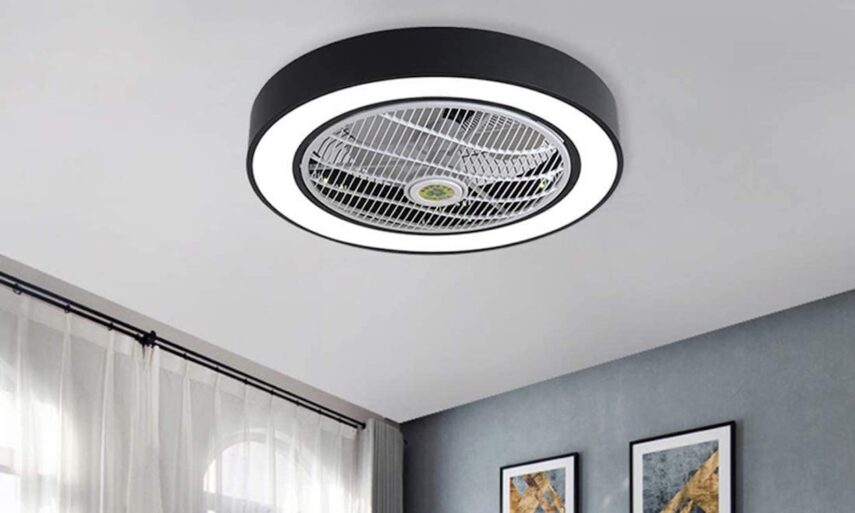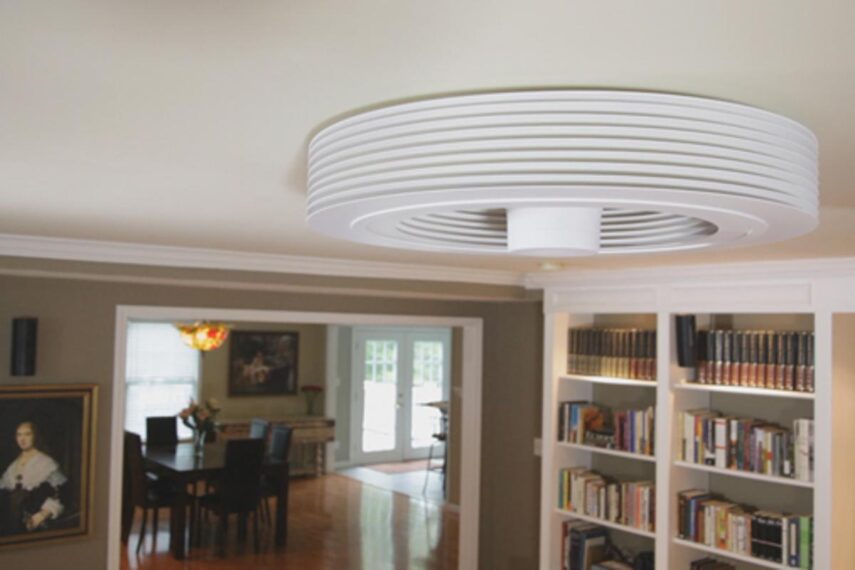Are you interested in the cutting-edge technology that underpins the newest style of ceiling fan, the bladeless fan? In this article, we will examine the mechanism of a ceiling fan without blades and the science behind its effective operation.
The popularity of bladeless fans, also referred to as air multipliers or air circulators, has grown due to their distinctive appearance and quiet operation. Find out how they generate a cool breeze without using conventional fan blades.
Bladeless Ceiling Fans: The Future of Home Comfort

In the world of home design and technology, evolution is constant, and innovations challenge traditional norms regularly. Among such groundbreaking developments is the emergence of bladeless ceiling fans.
At a glance, these devices may seem more like works of modern art than functional tools for air circulation, with their smooth, unbroken silhouettes replacing the familiar serrated edges of conventional fans. The design is not just about aesthetics, though; it’s rooted in efficiency and safety.
Bladeless ceiling fans operate on the principle of creating a continuous flow of air without the chopping motion typical of bladed counterparts. Through the use of internal impellers or turbines, these fans draw air into their base and then channel it out through a circular or oval aperture, creating a consistent, uninterrupted breeze.
The result is a quieter operation and a reduced risk of accidents associated with exposed blades, especially in households with children or pets. Additionally, without blades to gather dust or become unbalanced over time, maintenance is considerably simpler.
The absence of blades also allows for a more streamlined integration of lighting features, often resulting in a dual-purpose fixture that both illuminates and cools a room. With increasing emphasis on energy efficiency, some bladeless models have proven to be more energy-conservative, further solidifying their appeal.
As the fusion of technology, design, and sustainability continues to shape our living spaces, bladeless ceiling fans stand out as exemplars of innovation, proving that sometimes, what’s left out is just as crucial as what’s included.
Air Multiplier Technology
In the heart of a bladeless fan lies the pioneering Air Multiplier technology. Instead of using traditional blades to move air, these fans employ a jet engine-like mechanism to suck in air. Once air is drawn in through the base, it’s accelerated through an annular aperture, producing a jet of smooth air.
This flow then entrains the surrounding air, causing it to join the breeze. In layman’s terms, the device draws air in and multiplies its volume, emitting a consistent and uninterrupted flow.
This multiplication process enhances the fan’s output considerably. Imagine standing by a river and throwing a small stone; the ripples generated would represent the initial air intake. Now imagine a subsequent deluge of rain: the ripples would amplify, representing the multiplied air. The fan doesn’t merely blow out the air it draws in, but multiplies it, providing powerful circulation without the blades.
No Chopping Effect

Conventional fans, with their rotating blades, produce an inconsistent airflow known as the “chopping effect”. Each blade disrupts the air, causing a sensation of intermittent gusts rather than a smooth flow. This inconsistency can often be uncomfortable, making rooms feel stuffier than they are.
In the realm of bladeless fans, this predicament is non-existent. Their seamless design ensures the air is dispatched uniformly. It’s akin to comparing the choppy waters of a turbulent sea to the serene flow of a tranquil river. The uniformity offers not just consistent cooling but also ensures that every corner of your room receives an even amount of airflow.
Quieter Operation
Ask anyone about the perks of traditional ceiling fans, and noise won’t be on the list. The hum of rotating blades, coupled with the motor’s roar, often becomes white noise in our homes. Bladeless fans, with their state-of-the-art design, bring a refreshing change to this soundscape. Their motors are optimized for minimal noise, making them incredibly discreet.
This reduction in noise doesn’t come at the expense of performance. The fans are still powerful and efficient. Think of it as a library; while it’s quiet, there’s a lot of activity happening in silence. This quiet operation means that you can hold conversations, watch television, or simply relax without the ever-present background drone of a traditional fan.
Energy Efficiency

There’s a misconception that high-tech devices invariably consume more energy. Bladeless fans defy this notion. These modern marvels are optimized to be energy-efficient, often consuming less power than their bladed counterparts. With the emphasis on green technology and reducing carbon footprints, this feature stands out prominently.
Why the efficiency, you ask? The mechanism, while complex, minimizes resistance and wasted energy. Traditional fans lose energy due to the friction of blades cutting through the air.
Bladeless variants sidestep this issue entirely, ensuring that most of the energy they consume is directly used for cooling purposes. In the long run, they can significantly reduce electricity bills, making them a favorite among eco-conscious individuals.
Easy Maintenance
Dust, grime, and airborne particles love traditional fan blades. Cleaning them can be an arduous task, involving precarious balancing acts on chairs or ladders. Bladeless fans, however, introduce a simplicity to maintenance that many find appealing. With no blades to collect dirt, the cleaning process becomes straightforward and less frequent.
The absence of sharp, rotating elements also makes bladeless fans safer, especially in households with children or pets. Without the need to disassemble or maneuver around sharp edges, users find peace of mind. Thus, in addition to providing seamless airflow, these modern devices prioritize user safety and ease of upkeep.
Final Words

The functioning mechanism of a ceiling fan without blades is a marvel of engineering and design. With air multiplier technology, these bladeless fans offer an efficient, quiet, and energy-saving alternative to traditional fans.
They create a smooth, uninterrupted airflow, providing a more comfortable and enjoyable cooling experience. If you want to experience cutting-edge technology revolutionizing indoor air circulation, there is a simple solution. When you decide to upgrade your fan, consider a bladeless model like the ones available at todaysfans.com.







